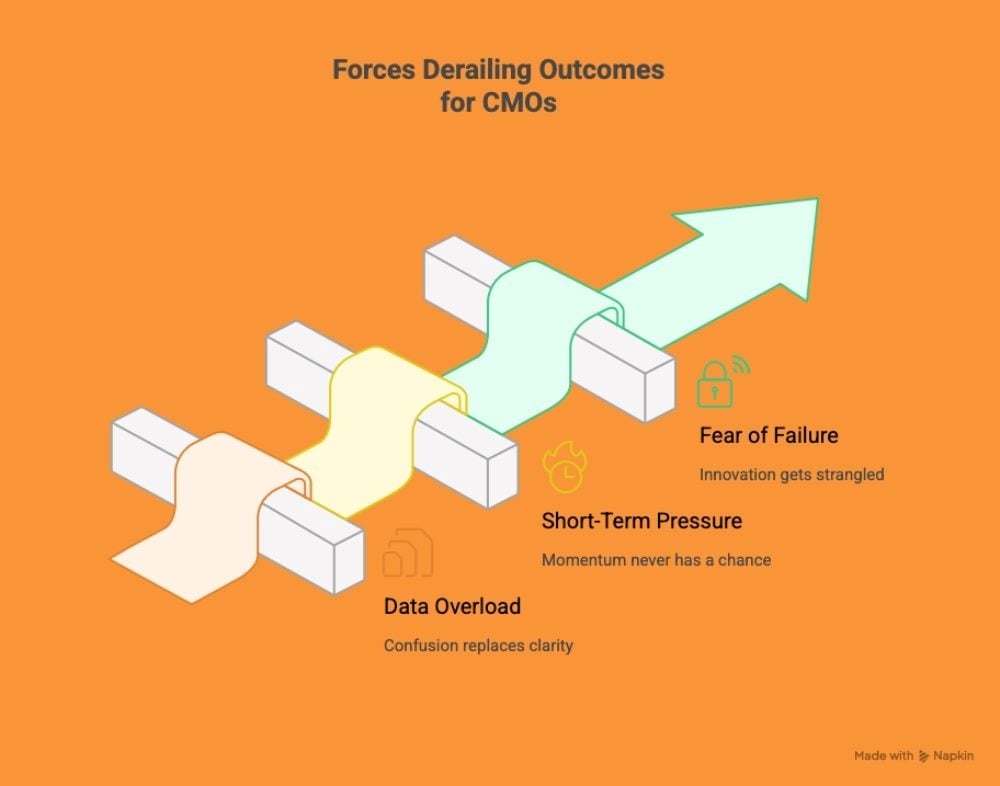The Gist
- Culture outlasts strategy. Real culture isn’t perks or posters — it’s trust, clarity, and accountability that convert effort into lasting business outcomes.
- CMOs shape culture through action. Marketing leaders build (or break) culture in how they define success, model accountability, and coach teams toward measurable outcomes.
- Outcomes create momentum. Strong cultures hardwire proof, focus on one anchor goal, and celebrate results over activity — turning marketing into a growth multiplier.
- Alignment beats activity. When culture, purpose, and strategy align, companies grow up to 316% faster — proof that culture isn’t soft, it’s structural.
- Legacy is measured by outcomes. Campaigns fade, but an outcome-driven culture defines the CMO’s true impact — multiplying strategy into growth that endures.
When Peter Drucker said, “culture eats strategy for breakfast," he referred to the impact of real culture, not the kind that rests on perks or platitudes. Real culture runs deeper. It’s the support you feel when the stakes are high. It’s the absence of dread on Sunday night. It’s being treated like a capable professional, not an employee number with tasks.
That kind of culture creates a force multiplier. When people work in an environment built on trust and clarity, they create results that become the connective tissue that accelerates innovation, strengthens collaboration and translates effort into durable growth.
It won’t endure on feelings alone. If culture is going to last, it must be reinforced by systems, metrics and rituals that make those feelings sustainable. That’s where marketing leaders show their weight: transforming culture from atmosphere into operating system.
From the CEO’s seat, I see setting the standard for internal culture as my #1 job. But it’s the CMO who decides how our culture shows up to the outside world.
And the stakes are real: nearly seven in 10 executives admit that when culture and strategy aren’t aligned, performance suffers. For the life of me, I don’t understand how it isn’t 10/10.
Table of Contents
- Technology Shifts, But Culture Persists
- The CMO’s Role in Shaping Culture
- Three Forces That Derail Outcomes
- Hardwiring Outcomes Into Marketing
- The Outcome Multiplier in Action
- Campaigns Die, Culture Doesn’t
Technology Shifts, But Culture Persists
The right combination of human trust and institutional reinforcement makes culture powerful enough to outlast tools, tactics and even strategies.
In weak cultures, effort may exist, but it seeps out through cracks instead of compounding. In strong cultures, the same energy connects and builds into momentum the business can measure.
I’ve written recently about the illusion of momentum (Discipline Over Disruption: The Secret Antidote to Marketing Waste) and the trap of celebrating delivery instead of results (Speed to Value Is the CX Metric That Actually Matters). The through-line is clear: activity is cheap, lasting impact is earned, and culture is the key ingredient making the difference.
And the data bears this out. Companies that align purpose, strategy and culture grow revenue 316% faster than peers. Adaptive cultures saw nearly 200% greater growth.
CEO perspective: Technology and tactics deliver spikes. Culture delivers staying power.
Related Article: Why the CMO Role Now Requires a Data Brain and a Storyteller's Heart
The CMO’s Role in Shaping Culture
Culture doesn’t float down from motivational posters. It shows up via the daily choices leaders make. In marketing, no one influences this more than the CMO. Their fingerprints are on every habit the team adopts (for better or worse).
The strongest CMOs shape it through the way they work.
- They model the behavior. When the CMO anchors on outcomes, the team learns to do the same. A leader who defaults to “what did we ship?” teaches the wrong lesson every time.
- They redefine success stories. The stories leaders choose to celebrate shapes the culture. Handing out high-fives for campaign reach or ad impressions lowers the bar. Spotlighting customer retention gains or revenue impact raises it.
- They operationalize accountability. Dashboards and cadences either reinforce discipline or expose drift. When reviews surface honest cause-and-effect between effort and results, the team sharpens. When they dissolve into updates and excuses, the edge dulls.
- They coach to outcomes. The most powerful question a marketer can internalize is: What business result are we driving? A CMO who insists on that question rewires how the team thinks. Over time, the discipline becomes muscle memory.
CEO perspective: From my seat, the tell is simple: if the culture inside marketing runs on outcomes, I know the CMO is leading. If it doesn’t, I have concerns.
Beyond the Barriers — The Culture-to-Outcome Connection
This table summarizes how CMOs can transform cultural pitfalls into drivers of clarity, momentum and innovation within their marketing organizations.
| Cultural Challenge | Underlying Risk | Outcome-Focused Response |
|---|---|---|
| Data Overload | Teams confuse more dashboards with more insight, creating noise instead of clarity. | Streamline metrics around one anchor outcome and establish consistent review cadences to link data to real results. |
| Short-Term Pressure | Quarterly goals dominate thinking, forcing reactionary decisions that erode long-term progress. | Balance short-term performance with durable growth by anchoring marketing objectives to sustained business value. |
| Fear of Failure | Risk aversion limits innovation, leaving teams hesitant to experiment or challenge the status quo. | Encourage experimentation and frame missteps as learning opportunities that strengthen strategic resilience. |
Three Forces That Derail Outcomes
A surefire way to spot a weak culture is by listening to the excuses. The words may change, but they usually fall into three familiar patterns.
“We’re reporting on everything.” That’s data overload in disguise. Teams convince themselves more dashboards equal more insight. We wrote an entire piece on this: Data Overload: The Silent Saboteur in Your Customer Data Strategy. The short version: too many metrics don’t create clarity, they create confusion.
“We have to make the quarter.” That’s short-term pressure eating long-term outcomes. When every decision is forced through the filter of the next three months, momentum never has a chance to build. Hitting a deadline looks good in the moment, but if it comes at the expense of durable results, the culture is mortgaging its future.
“We can’t afford to miss.” That’s fear of failure strangling innovation. Cultures that punish risk don’t eliminate mistakes, they eliminate progress. Safe work might preserve appearances, but it rarely translates into impact that lasts.
These forces show up in the numbers. Forbes reports that 71% of executives say lack of alignment across functions directly slows execution. From the CEO’s chair, I see that as drag — strategies that looked good in January but are crawling by July.
CEO perspective: CMOs who remove these barriers clear the path for their teams and earn credibility across the C-suite.
Related Article: CMOs Are No Longer Just Marketers
Hardwiring Outcomes Into Marketing
Outcomes stick when they’re embedded in how the function operates. That requires choices that are harder than they look.
- Pick one anchor outcome. It’s tempting to spread accountability across 10 metrics. Stronger cultures force themselves to choose one that proves marketing’s business value and then organize around it.
- Translate corporate ambition into marketing outcomes. Corporate goals are rarely written in executable marketing language. The CMO’s job is to close the gap and to decide which parts of the company’s ambition marketing can actually drive and rally their team and effort around this. When that translation is weak, marketing slides into order-taking as their primary activity.
- Build rituals that reinforce outcomes. Reviews, standups and cadences, oh my. The format matters less than the discipline. A culture only learns to live by outcomes if results are examined often and honestly.
- Create proof on demand. ROI modeling and attribution aren’t bureaucracy; they’re how marketing keeps its seat at the table. If it takes six weeks to explain impact, credibility’s long gone.
- Celebrate results. A culture becomes what its leaders choose to recognize. If effort gets applause, you’ll get more effort. If outcomes get applause, you’ll get better outcomes.
CEO perspective: When CMOs make outcomes a habit, reports about activities stop and proof of business impact starts. That shift changes how marketing is perceived in the boardroom.
The Outcome Multiplier in Action
At Yamaha Golf Car, marketing reoriented around a single corporate outcome: customer retention. That one decision reset the culture.
Retention as the north star gave campaigns sharper focus, aligned sales and marketing around a common goal and created space for smarter experimentation. Each choice built on the next. The gains in retention drove stronger engagement and those gains reinforced revenue.
This isn’t unique to Yamaha or any company, really. It’s the hallmark of a marketing culture that’s built to multiply.
CEO perspective: This is the pattern I look for. When marketing culture is anchored to outcomes, progress stops being linear and becomes self-reinforcing across collaboration, innovation and growth.
Insights From the 2025 State of the CMO Report
Editor's note: This table highlights data from CMSWire’s 2025 State of the CMO Report that reinforces how outcome-driven culture and leadership alignment drive marketing impact and organizational growth.
| Report Finding | What It Reveals | Why It Matters for CMOs |
|---|---|---|
| 69% of marketing leaders face pressure to deliver quantifiable ROI | ROI accountability has become the top leadership expectation, up 10 points from 2023. | Proves that outcome-driven cultures aren’t optional — they’re the standard by which CMOs are now judged. |
| 95% say their teams are under greater pressure to show ROI | ROI visibility now defines marketing credibility and cross-functional trust. | CMOs must turn activity tracking into proof of business impact to earn lasting C-suite confidence. |
| 97% agree that executing marketing strategy requires more technical competency each year | Modern marketing success depends on fluency in AI, analytics, and automation. | Outcome-driven leaders embed technical fluency into team culture — treating it as a core competency, not a side skill. |
| 66% cite “using AI more strategically” as a top two-year priority | CMOs see AI not as an experiment, but as a performance enabler when applied with discipline. | Outcome-driven cultures operationalize AI within marketing processes to accelerate measurable growth. |
Campaigns Die, Culture Doesn’t
Campaigns end and tactics fade, but culture endures. And when that culture is outcome-driven, the impact multiplies.
That’s the real measure of a CMO’s influence. Not the size of the budget or the number of campaigns, but whether they’ve built a culture that translates effort into results the business can feel.
So, Drucker was correct when he said culture eats strategy for breakfast. But the real test is what happens next: outcome-driven culture multiplies strategy to create growth that lasts. That’s the measure every CMO should be judged by and the legacy they leave.
Learn how you can join our contributor community.

